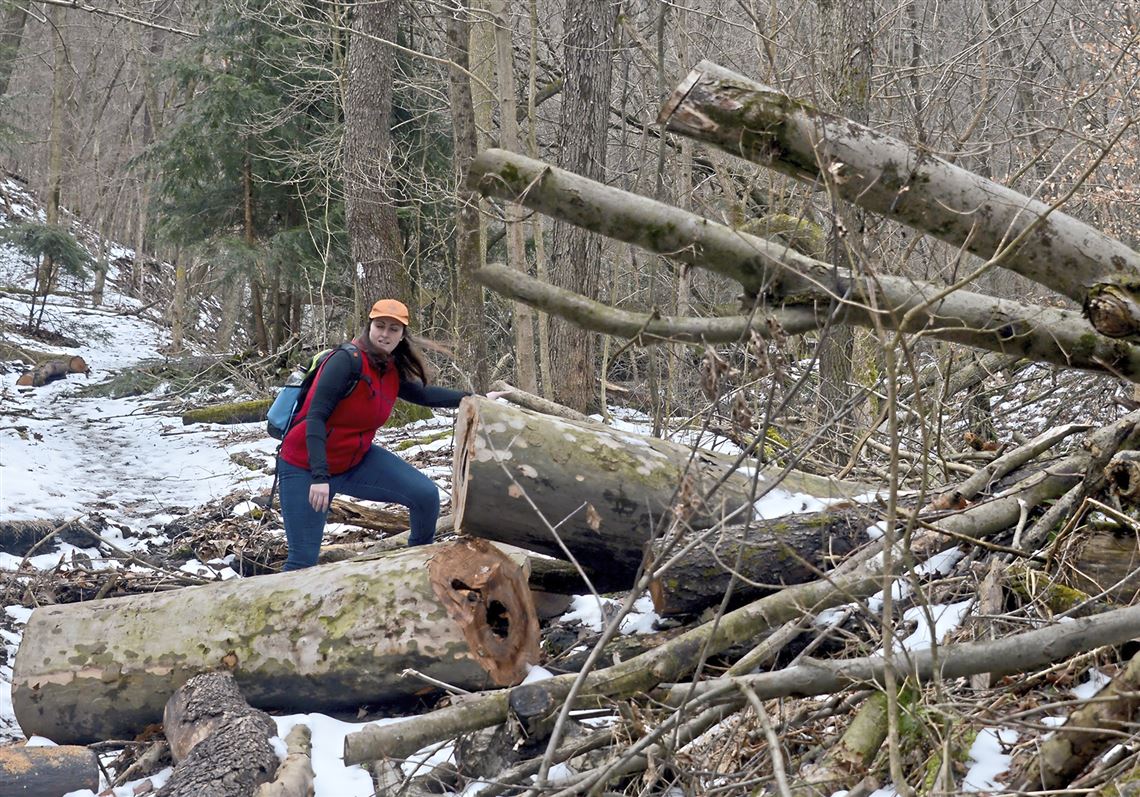A sycamore tree slammed to the ground in Dead Man’s Hollow near McKeesport late last summer, cutting off a section of narrow hiking trail that Dead Man’s Run later swept out of its banks to plunder. It rushed away with so much topsoil and subsoil that the trail was left a foot lower, exposing rusted pipes and ceramic remnants of a 19th-century industrial plant.
Caitlin Seiler, the Allegheny Land Trust’s director of volunteers and land resources, organized a crew to the site in October to chainsaw the tree where it blocked the trail.
The flood happened later. She saw those results on a recent visit in response to reports of a landslide — a massive avalanche of soil, trees and debris that throttled Dead Man’s Run.
That was dramatic, to be sure, but not as disastrous as landslides and floods that cause people to flee their homes or lose them. Landslides such as these are happening more frequently with record rains.
“There are places where people should not build,” said Thomas Dougherty, the land trust’s vice president of development and external affairs. “If we protect these areas, those problems can be mitigated.”
Dead Man’s Hollow was the trust’s first foray into land protection 25 years ago; it comprises 450 acres of rugged land along the Great Allegheny Passage — the bike trail that connects Pittsburgh with Cumberland, Md. — and along the Youghiogheny River in the Boston section of Elizabeth Township.
The Sewickley-based nonprofit since has acquired 2,500 forested, scenic and flood-prone acres to protect in perpetuity.
The pace at which green space is being consumed, however, is staggering by comparison — about 2,000 acres every year in Allegheny County, Mr. Dougherty said, citing new housing, commercial complexes and oil and gas infrastructure as the main reasons.
Trees, the most valuable resources for absorbing stormwater, also are disappearing. Allegheny County has lost 10,000 acres of tree canopy over five years, according to the U.S. Forest Service and Tree Pittsburgh.
“There needs to be a sense of urgency,” Mr. Dougherty said. “We don’t believe development is bad, but it should be done in the right places with an eye on what we should be conserving.”
In the land trust’s Vistas magazine in 2018, Roy Kraynyk, vice president of land protection and capital projects, wrote that land should be seen less as a commodity “to develop and profit from” and more as critical infrastructure “for flood control, carbon sequestration and scenic beauty.”
Sprawl is happening outside the city while population is not growing, he wrote, and “adding insult to injury,” the public purse is often opened to give land developers subsidies and infrastructure grants.
“People say we need more tax revenue,” he said recently. “But we can’t develop ourselves out of problems with air and water quality, flooding and landslides. There is so much land that could be redeveloped instead of sacrificing natural lands and tree canopy.”
The trust targets land rich in biodiversity and vulnerable to the impact of human activity, including watersheds. It also looks for opportunities to connect green spaces. One example is the 25 acres of easements it acquired to help make Emerald View Park in Mount Washington and Duquesne Heights a connective loop.
This month, the trust expects to close on 38 acres of the Montour Greenway Trail in Moon, having raised $90,000 to match a state grant.
The trust has 20 sites open to the public and 30 municipal partners. It boasts that every Allegheny County resident lives within 12 miles of a conservation site.
“But we have a long way to go,” Mr. Dougherty said.
‘This land is for sale’
A sense of urgency rallied residents of Franklin Park to stop a 41-lot townhouse development on 168 acres of steep woods in the Big Sewickley Creek watershed in 2014.
“A neighbor of the property showed up one day in the office and said, ‘This land is for sale,’ ” Mr. Kraynyk said. “The sellers had a subdivision plan drawn up,” but there was no resistance to the land trust’s decision to buy it, he said.
With $40,000 of its own money, the land trust got $100,000 from the municipality, $85,000 in community fundraising, $100,000 from the Pennsylvania Department of Conservation and Natural Resources and another $500,000 from state and county funds to buy the land.
The result is Linbrook Woodlands, which is adjacent to Franklin Park’s municipal Linbrook Park.
It has deep ravines and springs in common with Dead Man’s Hollow, but Dead Man’s Hollow is unique among land trust sites for the ruins of the Union Sewer Piping Co., which was destroyed by fire in 1925. Its infrastructure and ceramic relics remain on the site.
Just up from the ruins, along a narrow trail, is where the land plummeted this winter, blocking Dead Man’s Run. The landslide created a pool that bubbled gently at the edge of the debris, agitating to find an escape route through it.
“Water management has been a challenge,” the land trust’s Ms. Seiler said, viewing the damage. “Every time we start working on a trail, we discover a spring.”
Why saving green space matters
Springs, like steep hillsides, make the case for keeping a place natural.
“Even if a slide happens off-trail and we do no repairs,” said Lindsay Dill, the land trust’s marketing and communications director, “that protected land is still doing a lot of work to absorb rainwater.”
Natural landscapes sequester, on average, 850,000 gallons of water per acre, she said.
Penn State Extension reports that a single mature oak tree can consume more than 40,000 gallons a year.
The land trust survives on the support of six to eight foundations, individual donations and municipal, county and state grants. Its costs include environmental education, creating trails and maintenance. It gets land through bequests, direct sales and conservation easements.
“Easements are a good tool,” Mr. Dougherty said. “People can stay on the land and do whatever we agreed on, and we would own the easement for conservation in perpetuity.”
Wingfield Pines in Upper St. Clair is an example of environmental redemption — a forested floodplain that was once mined for coal. By creating a passive mine-water treatment system, the land trust turned the 87-acre site into a wetland — honeycombed, in part, by walkways. It draws birders, hikers and children for environmental education. It also mitigates flooding of Chartiers Creek.
The once-every-15-year flood happened three times last summer, Mr. Dougherty said, but Wingfield Pines absorbed the excess rain.
All the issues the land trust seeks to mitigate are increasingly relevant in the city, he said, noting that market forces are competing now for land that urban gardens first occupied 10 years ago.
The trust is working with Grow Pittsburgh to identify plots at risk in order to protect them.
“Meanwhile, our population is still flat with development going at a rampant pace.”
Diana Nelson Jones: djones@post-gazette.com or 412-263-1626. Twitter@dnelsonjones.
First Published: March 12, 2019, 12:00 p.m.




















